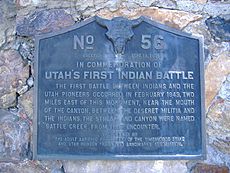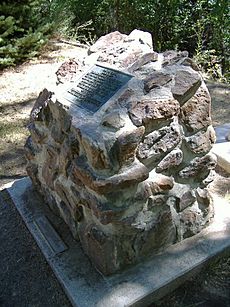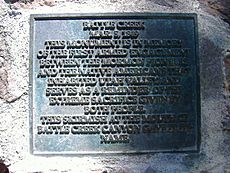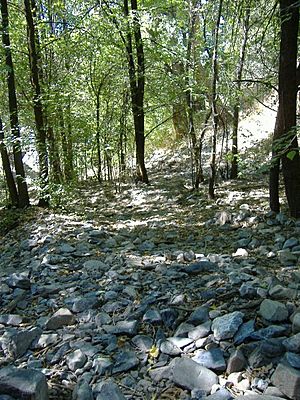Battle Creek massacre facts for kids
The Battle Creek massacre was a sad event that happened in Utah. It involved Mormon settlers and the Timpanogos Native Americans. The Timpanogos lived near Battle Creek, which is now Pleasant Grove, Utah.
Early on March 5, 1849, a group of Mormon soldiers, called the Deseret Militia, attacked the sleeping Timpanogos. The Native Americans were greatly outnumbered and didn't have enough weapons to defend themselves. This attack happened just before Mormon settlers began moving into Utah Valley.
Contents
What Led to the Confrontation?
Before the first Mormon settlers arrived in Utah Valley, a group of Timpanogos people were attacked. This happened near what is now Pleasant Grove, Utah. Mormon soldiers from Salt Lake City were sent on March 1, 1849. Their original mission was to find Native Americans who had supposedly stolen horses.
They were told to stop any future "depredations," which meant stopping any trouble the Native Americans might cause. The soldiers camped in the snow. They soon learned that the horses had not been stolen after all. However, their orders changed. They were now told to continue their mission because of problems with cattle.
The next morning, the soldiers continued south. They decided to kill a cow for breakfast. After eating, they traveled to the Jordan River and camped again. They received word a third time that the horses were not stolen. But the mission to deal with cattle issues continued.
On the third day, the soldiers entered Utah Valley, which is now Utah County. They split into two groups to search for the Native Americans. They searched all day without success. Finally, they camped near Utah Lake by American Creek, now American Fork, Utah. Everyone was tired and cold.
On Sunday, March 4, 1849, the soldiers started early. They traveled south to the Provo River. This area was described as a beautiful farming country. They found some Ute Native Americans there. These Utes seemed friendly but were also scared. The soldiers spent some time with them. They explained why they were there. Then they continued their journey. A Ute leader named Little Chief went with them for about three miles up the Provo River. They camped there for the night.
Two young Native American men joined the Mormon camp. They agreed to guide the soldiers to the group they were looking for. It was a clear night with a bright moon. The Mormons followed the Provo River to the mountains. Then they went north along the high mountain area, above present-day north Orem and Lindon, Utah. They left their horses in a cedar grove. Most of the soldiers waited there. A small group went ahead on foot. They soon saw campfires.
The fires were in the first creek north of the Provo River. The scouting party decided to go back and get the rest of the soldiers. Two men were sent to bring them. The others made small fires to stay warm. About two hours before dawn, the rest of the group arrived. Everything was ready. They just waited for daylight to attack.
The Attack at Battle Creek
The soldiers divided into four groups. This allowed them to surround the Native American camp. One group went to block escape to the mountains. Another group went to the mouth of the canyon. A few horsemen waited below on the creek. They were ready to chase anyone who tried to escape into the valley. The fourth group marched directly into the camp.
The Native Americans saw the soldiers as they were being surrounded. It was still twilight. They tried to escape in different directions but found themselves trapped. They ran towards the mountains, but white soldiers were there. They tried to go south, then west, and found blockades everywhere. The soldiers were closing in. No shots had been fired yet.
Before the shooting started, there was a conversation. The Native Americans told the Mormons to leave. The Mormons told the Native Americans to give up. Their guide tried to reason with the Native Americans. But they refused to surrender unless the soldiers left. The guide told them they must come out or die. The first person shot was their leader. Then, there was much crying and howling.
The battle began seriously. Soon, one Native American was killed, and several were hurt. During the fight, the soldiers stopped firing at times. Their interpreters and the young Ute guide tried to convince the Native Americans to come out. They also asked them to send out their women and children so they could be safe. But it didn't work.
Some of the women were found hiding in the water under thick bushes. They were convinced to come out. The soldiers were ordered to throw rocks into the bushes. This helped bring out more women and children. They were bruised and bleeding. Two men were told to build a fire for them. The women and children had been in the icy water for about an hour and a half. They were nearly frozen. The fire helped them get warm. After the women came out, the rest of the Native Americans also came out.
Two women were hurt on the head by stones. These stones were thrown to find where they were hiding. Soon after they surrendered, two more men were killed. Only one man was left. He tried to escape through the bushes to another Ute Native American who was watching from a hill. But he was killed before he ran far. The battle ended without any of the Mormon soldiers being hurt.
One young woman who was saved begged a soldier named Dimick B. Huntington to save her brother. Dimick agreed. She brought her young teenage brother out of the willows. The boy was defiant at first. Huntington threatened to kill him if he didn't give up their only gun. The boy got the gun from his family and surrendered it. Soon after, the three remaining Ute men ran away.
One Native American man almost got away. But he was shot and fell. He had 18 bullet holes, mostly through his body. He was running when he fell. It is believed no one escaped. This happened on the morning of March 5, 1849.
When the firing stopped, it was about 8 o'clock in the morning. The sun was high. Little Chief, the Ute leader, had ridden his horse from his home on the Provo River. He heard the gunshots. The morning was clear and calm. He rode ten miles up the mountainside. His horse was covered in sweat. Little Chief was crying.
He was very upset. He blamed himself and was angry at the white settlers. He said it would not be safe for two or three people to come there alone anymore. But soon after, a settlement and fort were built near his village in Utah Valley. The women and children who survived the attack went to Salt Lake City to live.
The soldiers arrived back in Salt Lake City on Tuesday, March 6, 1849, around 2 p.m. They were dismissed after their commander told a large crowd about their mission. Four days later, on March 10, Brigham Young called thirty men to settle Utah Valley. Their purpose was to farm, fish, and teach the Native Americans how to farm and live a "civilized" life. By March 17, thirty-three settlers were ready to leave. The "mission" was organized the next day.
For many years, the settlement near the attack site was called Battle Creek. Later, the Mormon settlers there agreed to change the name to Pleasant Grove.
After the Battle
Casualties
Most reports say four Native American men were killed. But one soldier, Oliver B. Huntington, said there were more. He stated that seven strong men were killed. When the soldiers returned to where they left the dead, the bodies were gone. They did not look for them again and started home.
Native American Women and Children
Huntington said the soldiers told Little Chief that the women and children would go home with them. They promised to give them good clothes, plenty of food, and houses. All the women and children received homes. They were cleaned, clothed, and fed like the white settlers. But this peace only lasted a few days. Then, they disappeared.
Captain Scott had promised that if the families came to Salt Lake, they would be treated kindly. This promise was kept for a time. Some orphaned Native American babies were even raised by the Mormon pioneers. Other children later returned to their Native American families with their mothers.
A Captured Boy: Possibly Black Hawk
A pioneer named Joshua Terry, who had married into a Native American tribe, once said that the boy captured after the Battle Creek fight became a famous Ute war chief named Antonga Black Hawk. After the Black Hawk War in the 1860s, Chief Black Hawk told Terry that he was that same boy. He said he never understood why the white men had killed his people. This made him bitter. Even though he lived with white people for some time, he always wanted to get revenge. That is why he later fought against them.
After the Battle Creek events, Little Chief warned the settlers that the boy would later kill a white man for revenge.
Local Leaders Distrust Settlers
Old Elk and Stick-in-the-Head were leaders of nearby Timpanogos tribes. They watched the settlers "relentlessly shoot down" the Utes. This made them distrust the settlers even more. This distrust played a part in events leading up to the Battle at Fort Utah later on.
Mormon Soldiers in the Attack
Here is a partial list of the Mormon soldiers who took part in the attack:
- Colonel John Scott, Commander
- Alexander Williams, Aide
- Sorenus Taylor
- Frank Woodard
- George Boyd
- Hosea Stout
- David Fulmer
- John Brown
- Oliver B. Huntington
- William G. Pettey
- John S. Fullmer
- John Lowry
- Dock Stoddard
- Judson Stoddard
- Shell Stoddard
- Irwin Stoddard
- Isaac (Ike) Hatch
- Dimick B. Huntington, Interpreter
- Barney Ward, Interpreter
Why Did the Battle Creek Attack Happen?
On June 28, 1847, almost a month before the first Mormon pioneers arrived in Utah, Brigham Young met with a famous mountain man named Jim Bridger. They talked about Utah Valley. A journal entry from that time noted that Utah Lake had good grass and clover. It also mentioned that the Ute tribe lived there and were considered "a bad people" who might rob or hurt lone travelers. However, groups of men were thought to be safe. The Utes mostly had guns.
The journal also said that Utah Valley was a very good place. It had plenty of trees, fish, and good land for farming. It was noted that Native Americans south of Utah Lake grew corn and wheat. Bridger believed the settlers could easily control the Native Americans there.
During their journey west, Brigham Young thought about what he heard about Utah Valley. It sounded like a paradise, but with Native American issues. He decided that the first settlement should be in Salt Lake Valley. This area was a "no-man's-land" between the Ute and Shoshone tribes. This would give them time to learn about the Native Americans' feelings. So, the first Mormon settlement was in Salt Lake City. Still, Young planned to explore all valleys and settle them when possible.
Months later, in 1848, many Mormon immigrants arrived. They spent the winter in Salt Lake City. But in the spring, a well-organized group of thirty families moved south. They went into Utah Valley, which was the chosen land of the Utes. Explorers had said it was a particularly good spot. So, it was natural for the Church leaders to want to settle this area next.
In 1847 and 1848, nearby areas were explored. Good reports about Utah Valley were given to Church leaders in Salt Lake City. Then, on January 6, 1849, Brigham Young sent ten men to Utah Valley. They were to check if it was good for raising cattle. On the last day of February 1849, the Mormon soldiers, called the Nauvoo Legion, were called to go south. This mission ended at Battle Creek, Utah. Some people might see this as an attack meant to prevent future problems with the Timpanogos (Ute) Native Americans living in Utah Valley.






